
Reconstructed tankard, Bow porcelain factory, London, ca. 1747. Soft-paste porcelain. (Department of Archaeological Research, Colonial Williamsburg Foundation; photo, Gavin Ashworth.)
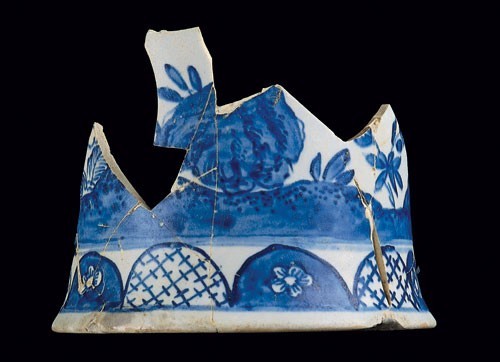
Tankard base fragments, Bow porcelain factory, London, ca. 1750–1752. Soft-paste porcelain. (Department of Archaeological Research, Colonial Williamsburg Foundation; photo, Gavin Ashworth.)
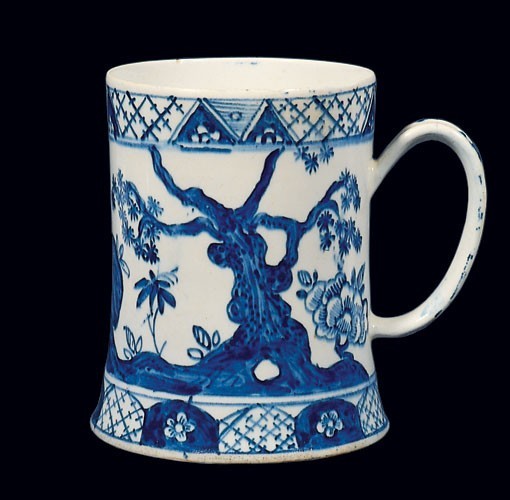
Tankard, Bow porcelain factory, London, ca. 1750–1752. Soft-paste porcelain. H. 6". (Courtesy, Roderick Jellicoe.)
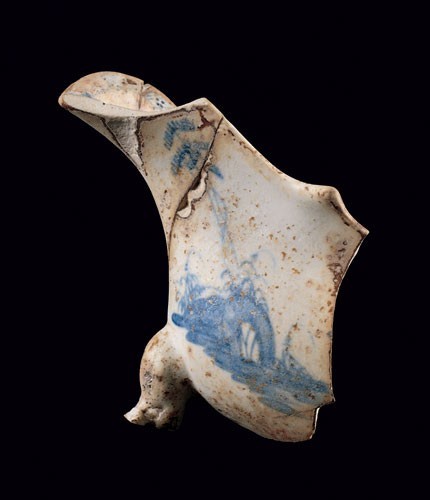
Sauceboat fragment, Bow porcelain factory, London, ca. 1750. Soft-paste porcelain. (Department of Archaeological Research, Colonial Williamsburg Foundation; photo, Gavin Ashworth.)
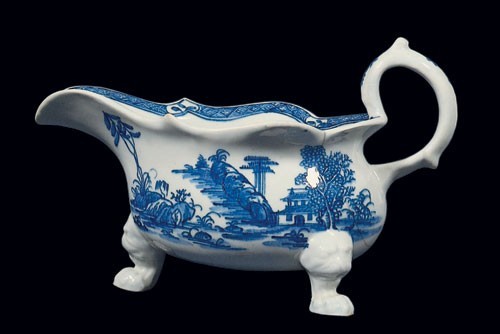
Sauceboat, Bow porcelain factory, London, ca. 1753–1755. Soft-paste porcelain. L. 7". (Courtesy, Roderick Jellicoe.) Note the molded lion-mask-and-paw feet.
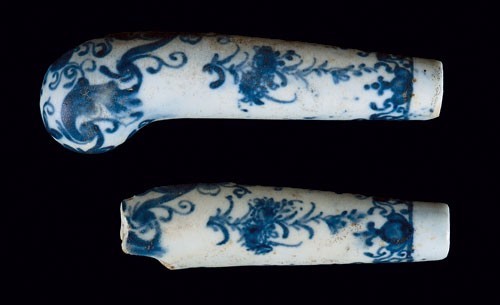
Knife handles, Bow porcelain factory, London, ca. 1758. Soft-paste porcelain. (Department of Archaeological Research, Colonial Williamsburg Foundation; photo, Gavin Ashworth.)
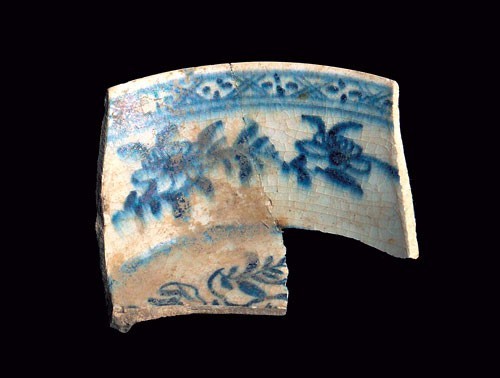
Patty pan fragment, Bow porcelain factory, London, ca. 1755. Soft-paste porcelain. (Department of Archaeological Research, Colonial Williamsburg Foundation; photo, Robert Hunter.)

Plate fragment, Bow porcelain factory, London, ca. 1756–1760. Soft-paste porcelain. (Department of Archaeological Research, Colonial Williamsburg Foundation; photo, Robert Hunter.)
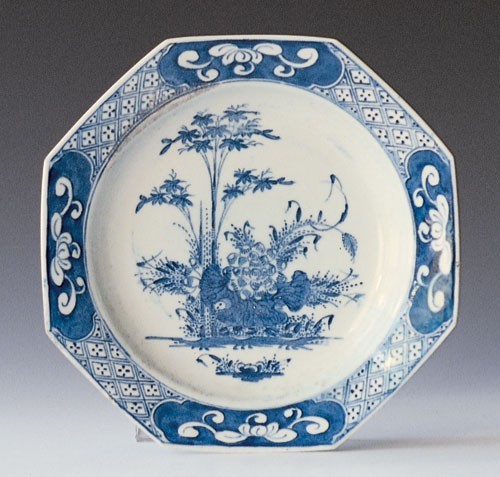
Octagonal plate, Bow porcelain factory, London, ca. 1758. Soft-paste porcelain. D. 9 1/2". (Courtesy, Roderick Jellicoe.)
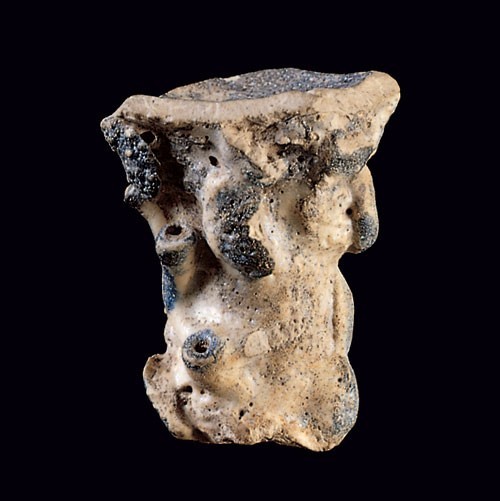
Pickle dish fragment, Bow porcelain factory, London, ca. 1760–1765. Soft-paste porcelain. (Department of Archaeological Research, Colonial Williamsburg Foundation; photo, Gavin Ashworth.)
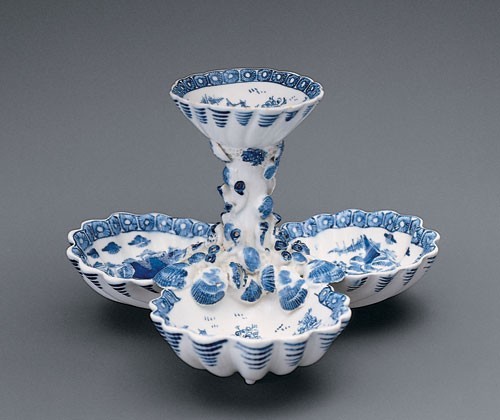
Pickle stand, Bow porcelain factory, London, ca. 1760–1765. Soft-paste porcelain. H. 5 1/2". (Courtesy, Kaufman Americana Collection; photo, Gavin Ashworth.)
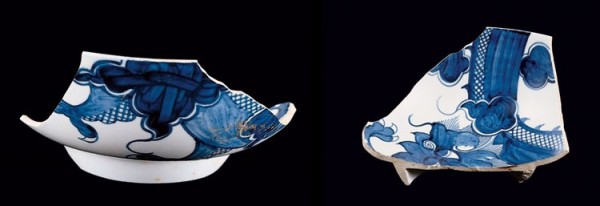
Punch bowl fragment, Bow porcelain factory, London, ca. 1755–1760. Soft-paste porcelain; Dragon pattern. (Department of Archaeological Research, Colonial Williamsburg Foundation; photo, Gavin Ashworth.)
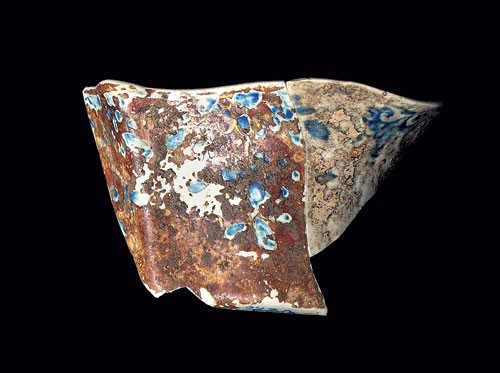
Sauceboat fragment, Bow porcelain factory, London, ca. 1752. Soft-paste porcelain; underglaze blue and overglaze iron red with gilt decoration. (Department of Archaeological Research, Colonial Williamsburg Foundation; photo, Robert Hunter.)
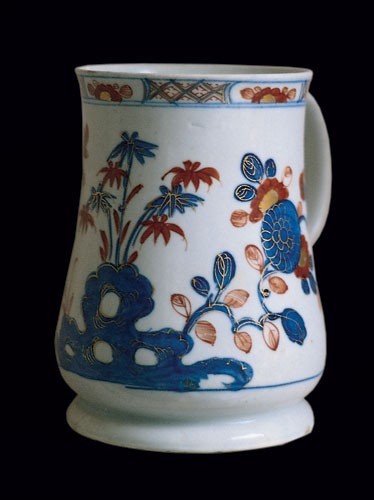
Mug, Bow porcelain factory, London, ca. 1750–1752. Soft-paste porcelain; underglaze blue and overglaze iron red with gilt decoration. (Courtesy, Roderick Jellicoe.)

Saucer fragments, Bow porcelain factory, London, ca. 1758–1760. Soft-paste porcelain; overglaze polychrome enamels. (Department of Archaeological Research, Colonial Williamsburg Foundation; photo, Gavin Ashworth.)
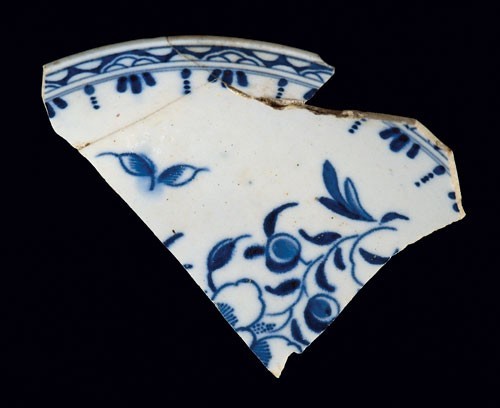
Saucer fragment, Worcester porcelain factory, ca. 1768. Soft-paste porcelain; Peony pattern. (Department of Archaeological Research, Colonial Williamsburg Foundation; photo, Gavin Ashworth.)

Teabowl and saucer, Worcester porcelain factory, ca. 1768. Soft-paste porcelain; Peony pattern. D. of saucer 5". (Courtesy, Roderick Jellicoe.)

Bowl fragment, Worcester porcelain factory, ca. 1765. Soft-paste porcelain; Waiting Chinaman pattern. (Department of Archaeological Research, Colonial Williamsburg Foundation; photo, Gavin Ashworth.)
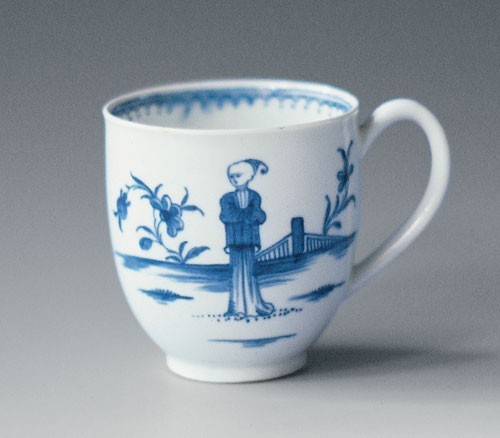
Coffee cup, Worcester porcelain factory, ca. 1765. Soft-paste porcelain; Waiting Chinaman pattern. H. 3". (Courtesy, Roderick Jellicoe.)

Saucer fragment, Worcester porcelain factory, ca. 1770. Soft-paste porcelain; transfer-printed in so-called European Landscape decoration. (Department of Archaeological Research, Colonial Williamsburg Foundation; photo, Robert Hunter.)

Punch bowl fragments, Chaffers porcelain factory, Liverpool, ca. 1760–1765. Soft-paste porcelain; unknown pattern. (Department of Archaeological Research, Colonial Williamsburg Foundation; photo, Gavin Ashworth.)

Tankard, Chaffers porcelain factory, Liverpool, ca. 1762–1765. Soft-paste porcelain. H. 6". (Courtesy, Roderick Jellicoe.)
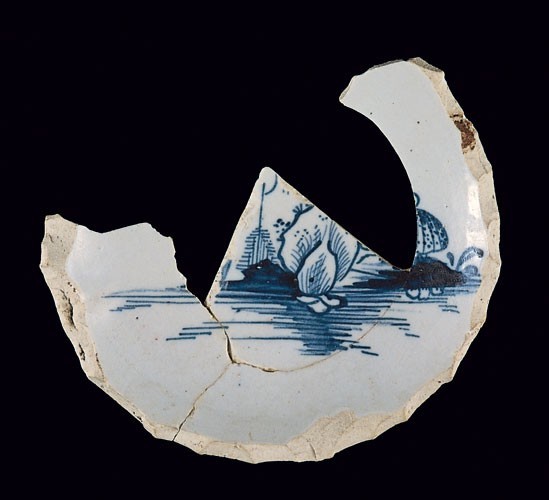
Punch bowl fragment, Chaffers porcelain factory, Liverpool, ca. 1760. Soft-paste porcelain. (Department of Archaeological Research, Colonial Williamsburg Foundation; photo, Gavin Ashworth.)
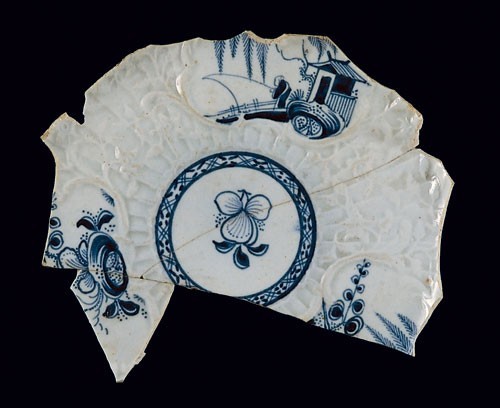
Saucer dish fragment, Christian porcelain factory, Liverpool, ca. 1765. Soft-paste porcelain. (Department of Archaeological Research, Colonial Williamsburg Foundation; photo, Gavin Ashworth.) Note the molded body and the panels painted in underglaze blue

Saucer dish, Christian porcelain factory, Liverpool, ca. 1765. Soft-paste porcelain. D. 8 1/2". (Courtesy, Roderick Jellicoe.)

Rim sherds, Liverpool, ca. 1768–1772. Soft-paste porcelain. (Department of Archaeological Research, Colonial Williamsburg Foundation; photo, Gavin Ashworth.) This assemblage shows a variety of Liverpool molded sherds with underglaze-blue decorative borders.
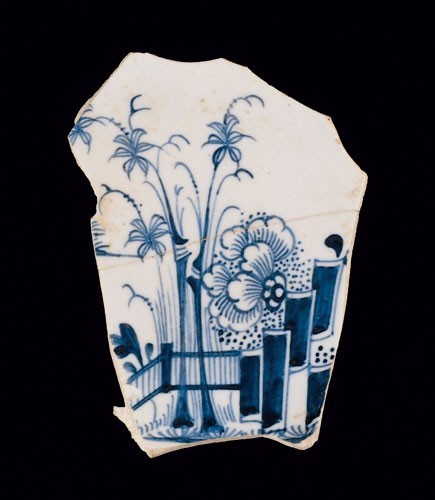
Dish fragment, Christian porcelain factory, Liverpool, ca. 1765. Soft-paste porcelain; Plantation pattern. (Department of Archaeological Research, Colonial Williamsburg Foundation; photo, Gavin Ashworth.)
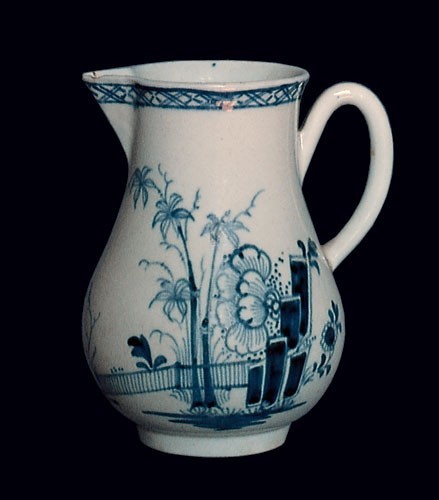
Cream jug, Christian porcelain factory, ca. 1768. Soft-paste porcelain; Plantation pattern. H. 3 1/4". (Courtesy, Roderick Jellicoe.)

Teabowl fragments, Christian porcelain factory, Liverpool, ca. 1765–1770. Soft-paste porcelain; Tufted Bird pattern. (Department of Archaeological Research, Colonial Williamsburg Foundation; photo, Gavin Ashworth.)
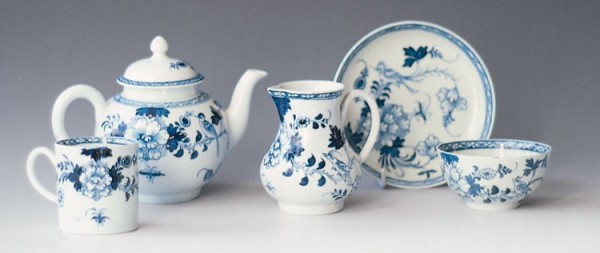
Tea wares, Christian porcelain factory, Liverpool, ca. 1765–1770. Soft-paste porcelain; Tufted Bird pattern. (Courtesy, Roderick Jellicoe.)
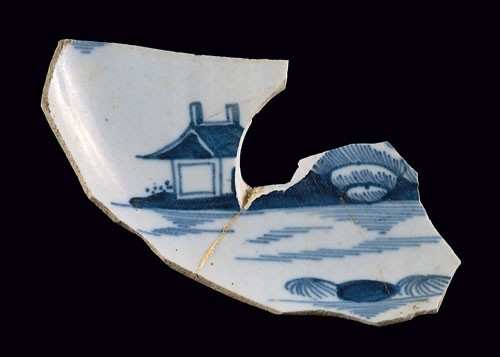
Saucer fragment, Christian porcelain factory, Liverpool, ca. 1765. Soft-paste porcelain; Cannonball pattern. (Department of Archaeological Research, Colonial Williamsburg Foundation; photo, Gavin Ashworth.)

Teapot, Christian porcelain factory, Liverpool, ca. 1768. Soft-paste porcelain; Cannonball pattern. H. 5". (Courtesy, Roderick Jellicoe.)
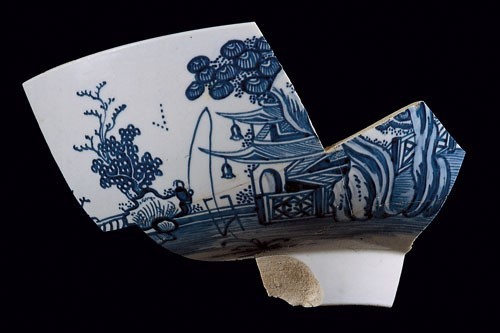
Punch bowl fragment, Christian porcelain factory, Liverpool, ca. 1768–1772. Soft-paste porcelain; Chinaman Fishing on an Island pattern. (Department of Archaeological Research, Colonial Williamsburg Foundation; photo, Gavin Ashworth.)
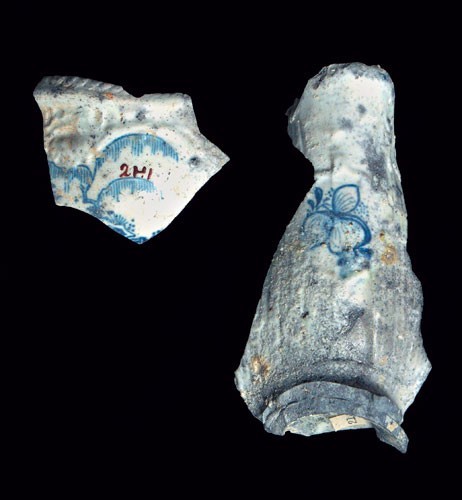
Sauceboat fragments, Christian porcelain factory, Liverpool, ca. 1768–1770. Soft-paste porcelain. (Department of Archaeological Research, Colonial Williamsburg Foundation; photo, Gavin Ashworth.)

Sauceboat, Christian porcelain factory, Liverpool, ca. 1768–1770. Soft-paste porcelain. L. 5 3/4". (Courtesy, Roderick Jellicoe.)
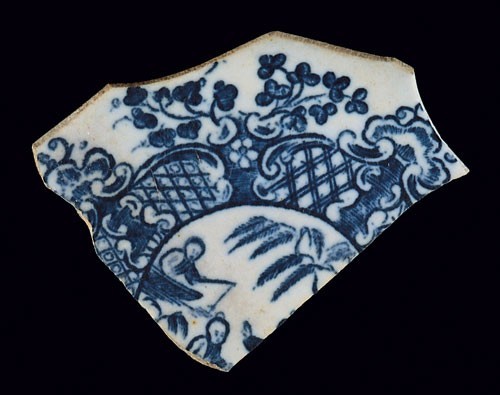
Saucer fragment, Christian porcelain factory, Liverpool, ca. 1770. Soft-paste porcelain; Mother, Child, and Man Fishing pattern. (Department of Archaeological Research, Colonial Williamsburg Foundation; photo, Gavin Ashworth.)

Teapot, Christian porcelain factory, Liverpool, ca. 1770. H. 5". Soft-paste porcelain; Mother, Child, and Man Fishing pattern. (Courtesy, Roderick Jellicoe.)

Sauceboat fragment, Liverpool China Manufactory (William Reid), Liverpool, ca. 1760. Soft-paste porcelain. (Department of Archaeological Research, Colonial Williamsburg Foundation; photo, Gavin Ashworth.)

Sauceboat, Liverpool China Manufactory (William Reid), Liverpool, ca. 1760. Soft-paste porcelain. L. 7 1/4". (Courtesy, Roderick Jellicoe.) The sauceboat is juxtaposed next to sherds recovered during the archaeological excavation of Reid’s factory in Liverpool.
The success of the American China Manufactory in Philadelphia hinged on many factors, the most important being a market for its soft-paste porcelain products. Consumers in eighteenth-century Philadelphia were certainly aware of the full spectrum of available Chinese and English porcelain goods, and the desire for both is indicated in contemporary merchant advertisements. However, to what degree these goods were part of Philadelphia-area households is—surprisingly—impossible to measure, as no comprehensive contextual, documentary, or archaeological studies on this topic have been conducted for this important American city.[1] That this is so is surely a call for rigorous research in the future.
In contrast, Williamsburg, the capital of Virginia in colonial America yet very small compared with Philadelphia or Boston, is the most extensively studied eighteenth-century Anglo-American town in the world. The sheer volume of its documentary and archaeological resources—with extant probate inventories and more than fifty years of careful excavation conducted on a lot-by-lot, house-by-house basis—exceeds that available for any other American city, large or small. Not surprising, then, is that it is sherds recovered from Williamsburg’s archaeological contexts that demonstrate the prevalence of English soft-paste porcelain in colonial America.[2]
Much research has been conducted on the history and products of the major English porcelain factories, but almost none has been undertaken on how the products were purchased and used by either American or English consumers. Greater emphasis and study have been devoted to the use of English pottery, which, along with Chinese porcelain, was imported in large quantities from the early seventeenth century until well into the nineteenth. Consequently, archaeological studies of English pottery retrieved from American sites have been comprehensive, providing an encyclopedic history of British pottery.[3] Less has been gleaned from Chinese porcelain taken from archaeological contexts, but enough has been done to provide ceramic historians with a rudimentary outline of the chronology of styles.[4]
English porcelain occurs in many archaeological assemblages from the 1750–1770 period but in comparatively small quantities.[5] When it is not ignored outright, English porcelain is generally lumped into a single typological category and not classified by factory or decoration. Partly this stems from many archaeologists’ inability to distinguish English soft-paste porcelain, in its fragmentary state, from hard-paste Chinese porcelain. An example in the analysis of artifacts recovered from excavations at Benjamin Franklin’s house in Philadelphia illustrates this common dilemma.[6] In the tabular list of all of the artifacts recovered from the excavation, there appears under the heading “Porcelain” the following note: “[Porcelain represents] 12.4% of the total sherd counts. The Chinese porcelains were represented by 370 sherds, of which 284 were ‘Canton’. Ten sherds were of Japanese manufacture and 1 was French. Unidentified porcelain sherds of European character totaled 16.” These “sherds of European character” are likely English soft-paste porcelain, but it would be much more satisfying to have them identified by factory, decorative pattern, and date. We know that Franklin ordered “English china” for his wife in 1758 and that subsequently he was an enthusiastic supporter of the Bonnin and Morris enterprise. Such vague analytic entries relating to English porcelain identification are all too common in American eighteenth-century site reports.[7]
Even though we know that English porcelain was present in many American households from the 1750s through the 1770s, the paucity of analytical study gives the impression that archaeologists and ceramic historians are disinterested in the topic. The situation is much the same in the study of eighteenth-century domestic sites in England.[8] Furthermore, the most basic of guides to help archaeologists identify English porcelain patterns is sadly lacking.[9]
The most important summary to date of English porcelain in colonial America was written by English ceramic historian Terence Lockett in 1998.[10] Much of Lockett’s data is impressionistic, but he nevertheless took an important first step by framing the research problems of this subject, beginning with an overall view of the trade and the political and economic factors controlling it. The exportation of English porcelain to America depended not on any of the manufactories but was orchestrated by general merchandise shippers who exported all sorts of goods from the ports of Bristol, Glasgow, Liverpool, London, and Whitehaven. The largest cargoes would have entered the American ports of Portsmouth, Boston, New York, Philadelphia, Baltimore, Charleston, and Savannah. Shipping records indicate that the ceramics trade was diverse and robust, which suggests that American consumers had the same access to the most fashionable ceramics as their English counterparts.
Having made clear the mechanisms of how porcelain was imported to America, Lockett then identified three types of documentary sources that offer insight into the presence of English porcelain in colonial America: newspaper advertisements, merchant records, and individual household probate inventories.[11] Advertisements from most of the major colonial-era newspapers have been collected and published. Their level of detail varies and often one cannot be sure whether the term china refers to Chinese or English products. One exception is an entry placed by Norfolk merchants Balfour and Barraud in the Virginia Gazette for July 25, 1766: “Just imported, and to be sold by the subscribers, at their store in NORFOLK, the following articles, VIZ...English china of all sorts, dessert plates....” (In the 1760s Norfolk was an entry port for many of the goods bound for Williamsburg merchants.)
American merchant records show great potential for illuminating the kinds of details needed to understand the variety of forms and relative prices of the English porcelain imported by American merchants. These records show that English porcelain was generally more expensive than its Chinese counterpart. However, in one case highlighted in Lockett’s discussion of Beekman Mercantile Papers, 1746–1799, he cites the correspondence between James Beekman of New York and London ceramics dealer Thomas Harris on July 7, 1767:
I have made some Alterations in your Order for China doubling the Quantity in some particulars foreign China and making it less or more in English China as I have found the price best to suit for your Market. Coffee Potts in foreign China are very high, in English near the half the Price.[12]
This observation about the relative prices of Chinese and English coffee pots shows a significant exception to the trend of Chinese porcelain being less expensive than English porcelain. Cost was not the only consideration, however; customers sought out specific colors and decorations for their tables, some of which were not always available in both English and Chinese wares. More research into these fascinating merchant papers could reveal much about the decorative preferences of American customers.
Most colonial household inventories provide almost no information regarding decoration and color, but overall these documents do provide some evidence of the presence of English porcelain. Inventory details vary considerably, of course, and, as with newspaper advertisements, a specification of the porcelain’s origin—England or China—is rare. A couple of notable exceptions exist in the Williamsburg records. The most widely published example is the inventory for Norborne, Baron de Botetourt, governor-general of Virginia from 1768 to 1770. Among the hundreds of ceramic objects listed in his estate at the time of his death, in 1770, are “11 Chelsea china figures” in the governor’s palace. Another citation of Chelsea ceramics is found in the estate of Peyton Randolph’s widow, Elizabeth Harrison Randolph, which lists a “set of Chelsea Tea China.”[13] Most inventory data do not come close to this specificity, although these documents, along with merchant records and other correspondence, do make it clear that every type of tableware, tea ware, and ornamental ware produced in England in the 1750s and 1760s was being exported to America.
New discoveries continue to surface that add to our ability to make more precise identifications. The recovery of large quantities of porcelain fragments and wasters from an eighteenth-century factory site in Liverpool, for example, made it possible to identify the products and attribute them to the Liverpool China Manufactory of William Reid.[14] Reid was also a merchant and therefore would have been involved in the export of ceramics to America. In the final analysis, archaeology is the best tool to discover the specific products used and their vessel form, decoration, factory of origin, and manufacturing date range.
Having said that, we must keep in mind that identifications in published archaeological reports remain suspect. Even though some data might be usable, Lockett’s somewhat polite critique of one Philadelphia archaeological report warns of potential problems:
Though Chinese predominated, there were a dozen or so reconstructed English objects on show, including plates, bowls and cups and saucers, mainly blue and white. These were variously attributed to Bow, Worcester and Liverpool (no specific factories). I have to add that judging purely on the wares illustrated, I would not be entirely happy with the precise details of all the attributions offered.[15]
Lockett’s assessment of the competence of American archaeologists to identify English porcelain products brings us to a new consideration of the Williamsburg porcelain finds. Working closely with Bill Pittman, the curator of Colonial Williamsburg’s archaeological collection, we examined the English porcelain sherds held in the study collection maintained by the Department of Archaeological Research. From this collection a sample of the sherds was photographed and illustrates this article. The purpose of the initial study was simply to gauge the potential for identifying specific factories and decorative patterns in this sample; no attempt was made to relate the sherds to specific households or other historical information.
The majority of the English porcelain fragments found on historic sites in America relate to the Bow factory in London and to the Liverpool manufacturers. In the past, some sherds recovered from Williamsburg were traditionally attributed to the Worcester porcelain factory. From the very selective study collection examined for this article, about 75 percent of the sample appears to have originated from Liverpool, about 20 percent from Bow, and the remaining 5 percent from Worcester, with one or two pieces from smaller producers such as Lowestoft and, possibly, a fragment from Vauxhall.
The Bow factory started producing porcelain about 1745 and was the main source of the English porcelain used in Williamsburg until about 1760 (after which the majority of the fragments are from Liverpool). The beginnings of Bow porcelain have an American association when in 1744 a patent was taken out for a porcelain recipe that included unaker or Cherokee clay, found in the Franklin region of North Carolina.[16] W. Ross Ramsay, Judith A. Hansen, and E. Gael Ramsay suggest that this clay was supplied by Savannah potter Andrew Duché and was used in the early manufacture of Bow porcelain.[17] A shipment of about twenty-nine tons of Cherokee clay arrived in London in 1743/44. Little is known of what was produced under this first patent, but chemical analysis by Ramsay et al. suggests that it could be the mysterious “A-marked” group. “A-marked” porcelain comprises a small group of finely potted wares of a distinctive character, some of which are marked on the base with a painted or incised capital “A.” Several attributions have been put forward over the years, but the recent suggestion of early Bow is now becoming generally accepted. No sherds have yet been identified in America with this early type of body.
Another link between the Bow factory and America arose from the establishment by Bonnin and Morris of the American China Manufactory in Philadelphia in 1770. It is likely that several potters came from Bow to work in this new factory, and several of the shapes, styles, and patterns used by Bonnin and Morris can be traced back to Bow.
The Bow porcelain sherds found at Colonial Williamsburg provide a starting point—the late 1740s—for exploring what might have been used in other American households. One of the earliest pieces is a large tankard, which has been partially reconstructed by the conservation department at Williamsburg (fig. 1). It is decorated in bright underglaze blue with a very simple naive pattern and dates from about 1747. The early flared mug base of another Bow tankard is shown alongside an intact example painted with the same pattern (figs. 2, 3). A significant Bow fragment observed in the collection from this early period but not illustrated is a lid from a very early sucrier or sugar dish.
Among the several Bow porcelain sauceboats represented in the collection was a silver sauceboat form (fig. 4), which is shown next to a similar but simplified version of slightly later date also standing on three lion-mask-and-paw feet (fig. 5). Other forms in Bow porcelain in the Williamsburg collection are knife handles (fig. 6), patty pans (fig. 7), and plates (figs. 8, 9). Of particular interest was a central stalk from a triple-shell sweetmeat dish (fig. 10). The stalk belongs to the Bow form that was closely imitated by Bonnin and Morris and suggests that the English variety of these pickle stands were not uncommon in America (fig. 11).
A variety of decorative patterns were observed, such as the Dragon motif adorning a large punch bowl (fig. 12). Originating on Chinese porcelain and subsequently used in English delft and by several English soft-paste porcelain manufactories, the Dragon pattern seems to have been very popular in colonial America, and examples on Chinese porcelain, delft, and English porcelain are found in American archaeological contexts. The pattern was also used on English creamware and china glaze, although specimens have yet to be found archaeologically.[18]
Several Bow sherds were decorated in underglaze blue and overglaze iron red (figs. 13, 14) and a few with polychrome enamels (fig. 15). In general, however, polychrome fragments were not found in any great quantity; blue-and-white–decorated porcelain was much more common and probably better suited for everyday use.
A small quantity of Worcester sherds were part of the examined collection, the earliest being a large fragment of a circa 1753 blue-painted Worcester coffee can from the so-called Scratch Cross period. Decorated in blue, the specific pattern could not be discerned. Other Worcester pieces of a later date were readily identified by their particular pattern. Figure 16, for example, shows a fragment of a saucer painted with the Peony motif, the overall decoration used on the antique example illustrated in figure 17. A small sherd painted with a flower on a fence forms part of the so-called Waiting Chinaman pattern, which was popular on a range of tea wares from the mid-1760s to the early 1770s (figs. 18, 19). A transfer-printed fragment shows part of a tree, possibly from the European Landscape series or the Birds in the Tree pattern (fig. 20).
By and large there is clear indication from the fragments discovered at American colonial sites that the town of Liverpool played an important part in the development of the Atlantic trade. In addition to being a major shipping port, Liverpool had several porcelain-producing factories. The Liverpool porcelain sherds examined in the Williamsburg collection are of pre-Revolutionary War manufacture and are attributed to the various factories of Richard Chaffers, Philip Christian, and William Reid.
Richard Chaffers was born about 1722. His family was from Yorkshire, and his father, Thomas, was a shipwright. The first recorded mention of Richard Chaffers as a potter is in his petition to be admitted to the freedom of the borough on October 5, 1743, for the sum of 6s. 8d. On November 23, 1744, he married Ann Johnson of Liverpool at St. Mary’s Church and they had fourteen children, six of whom died in infancy. Chaffers was a man of some standing in Liverpool. He held the post as overseer to the poor and, in 1774, was elected to the Liverpool chamber of commerce. At his death he was survived by his wife and eight children.
A painted design of flowers growing from stylized rocks can be seen in both a large section from a Chaffers tankard (fig. 21) and a complete example (fig. 22). The examples of Chaffers porcelain include a variety of different vessel forms—coffee cups, saucers, and large punch bowls (fig. 23).
After Richard Chaffers died, in 1765, Philip Christian continued running the factory on his own account. Ann Chaffers retained a considerable financial interest in the company, however, until 1769, when Christian bought her out for the sum of twelve hundred pounds. Having full control of the company, Christian brought his son Philip Christian Jr. into the firm, and from then on traded under the name Philip Christian and Son. He continued to make porcelain in Chaffers’s former factory until 1778, when the factory was taken over by Seth Pennington. The largest portion of identifiable English porcelain fragments found at Colonial Williamsburg came from Philip Christian’s factory.
Christian specialized in molded wares, and a variety of molded designs were found on tea ware fragments. The most distinctive example was a section of a saucer dish bearing pleat molding overlaid with floral sprays and with a central painted flower spray (figs. 24, 25). The three cartouches are painted with different oriental scenes. This type of molded and painted decoration can be found on a full range of Christian tea and coffee wares. Fragments with different moldings are represented by a variety of painted blue borders (fig. 26). A large section from a saucer is painted with the well-known Plantation pattern (figs. 27, 28).
Also found were sherds painted with the Tufted Bird motif (fig. 29). This pattern was used by Chaffers and potter James Pennington and is occasionally found on delftware, but all of the examined sherds painted with this design belong to the Philip Christian group. This attribution is easy to recognize because of the presence of a large number of dots incorporated in the painted decoration on the Christian porcelain (fig. 30). Similarly, the Cannonball pattern was used by many English porcelain factories but in Williamsburg occurs only on Christian’s porcelain fragments (figs. 31, 32).
Several large bowls painted with the Chinaman Fishing on an Island motif were noted (fig. 33). A section of a molded Christian’s sauceboat with a pedestal foot has been matched to a surviving example painted with the same pattern (figs. 34, 35). Christian’s underglaze-blue transfer printing is also represented in the finds—the Mother, Child, and Man Fishing design appears on a saucer excavated in Williamsburg and on an antique teapot illustrated for comparison (figs. 36, 37).
Sauceboats were a common English porcelain product, and many different examples reside in the Williamsburg collection. Of particular interest is one that relates to recent excavations at the Liverpool China Manufactory of William Reid (figs. 38, 39). The factory was built about 1755 and was created specifically to produce porcelain, in contrast to two other early Liverpool porcelain makers, Richard Chaffers and Co. and Samuel Gilbody, who made delft and possibly salt-glazed stoneware as well. Reid is a man of interest to us not only because of his ability to make porcelain but also because of his activities as a merchant.
Reid was the first potter to advertise the sale of Liverpool porcelain, on November 12, 1756.[19] His factory, known as the Liverpool China Manufactory, was the largest and most important producer of porcelain in Liverpool at the time. The factory was under Reid’s control from 1756 until 1761, when the partnership went bankrupt. The factory was kept running before passing into the control of James Pennington in 1763. Like his father, William Reid was primarily a wealthy merchant and was also involved in the export trade of goods (such as china) to America. He was also involved in manufactured goods, slaves, and sugar between England, Africa, and the American colonies. With these varied activities, Reid’s porcelain must have entered many of America’s main ports, suggesting a widespread distribution throughout colonial America.
Detection of Reid’s and other English factories’ porcelain in American archaeological assemblages awaits more astute examination by porcelain specialists. The cursory look at Williamsburg’s archaeological holdings helps frame the question: If English porcelain is found on so many circa 1750–1770 Williamsburg archaeological sites, then what of other large cities in America? In 1760 Williamsburg was a small government center with a population of about 1,000, so what can we deduce about Philadelphia, a major American city with nearly 25,000 residents? English porcelain must have been present in all of America’s urban centers, and accordingly it should receive greater attention from both archaeologists and ceramic historians.
This preliminary study emphatically affirms that England’s soft-paste porcelain was much more widely used in America than has been suggested by most published reports and supports the notion that there was a ready market for Bonnin and Morris to tap into when they set up their factory in America. When sufficiently analyzed, English porcelain sherds can be attributed to specific factories and dates of production, as well as reveal important information about form and decoration. With the renewed interest in understanding the porcelain of Bonnin and Morris, it is hoped that more attention will be paid to the English products that served as the catalyst for this short-lived American manufactory.
ACKNOWLEDGMENTS
The senior author would like to acknowledge the contributions of Gavin Ashworth, David Atherton, Ron Fuchs, Anton Gabszewicz, Pat Halfpenny, Lyn and Maurice Hillis, Kelly Ladd, Bill Pitman, and Ross Ramsay.
John L. Cotter, Daniel G. Roberts, and Michael Parrinton, with assistance of Sarah S. Evans, The Buried Past: An Archaeological History of Philadelphia (Philadelphia: University of Pennsylvania Press, 1993). This is the major summation of archaeological research conducted in Philadelphia discussing only a few site-specific investigations.
Roderick Jellicoe, “English Porcelain in Colonial America: Sherds from Colonial Williamsburg,” paper presented at the 2004 Ceramics in America Conference, Winterthur, Delaware.
Ivor Noël Hume, A Guide to Artifacts of Colonial America (1970; Philadelphia: University of Pennsylvania Press, 2001).
Andrew David Madsen, “‘All sorts of China Ware . . . Large, Noble and Rich Chinese Bowls’: Eighteenth Century Chinese Export Porcelain of Virginia” (Master’s thesis, Department of Anthropology, College of William and Mary, Williamsburg, Va., 1995).
One horseback estimate suggests that porcelain usually constitutes less than 5 percent of most domestic assemblages from the 1750s to the 1770s, and the vast majority of it is of Chinese origin. A survey of archaeological assemblages from the Chesapeake region indicates that fragments of English porcelain are present in nearly every archaeological collection from this time period.
Bruce B. Powell, “The Archaeology of Franklin Court,” 1962, on file at Independence National Historical Park, Philadelphia; cited in Cotter et al., Buried Past, p. 143.
Alice Morse Earle, China Collecting in America (1892; Rutland, Vt.: Charles E. Tuttle Co., 1982), p. 64.
Research on eighteenth-century English porcelain from excavated consumer sites in London is currently being conducted by Jacqui Pearce, specialist at the Museum of London. A paper is scheduled to be presented at the January 2008 meeting of the English Ceramic Circle.
Ivor Noël Hume, Pottery and Porcelain in Colonial Williamsburg Archaeological Collections (Williamsburg, Va.: Colonial Williamsburg Foundation, 1969).
Terence Lockett, “English Porcelain and Colonial America,” English Ceramic Circle Transactions 16, pt. 3 (1998): 283–97.
Ibid., p. 287.
Ibid., p. 289.
John C. Austin, Chelsea Porcelain at Williamsburg (Williamsburg, Va.: Colonial Williamsburg Foundation, 1977), pp. 10–11.
Maurice Hillis and Roderick Jellicoe, Liverpool Porcelain of William Reid, exh. cat. (London: Roderick Jellicoe, 2000).
Lockett, “English Porcelain and Colonial America,” p. 293.
W.H.R. Ramsay, Anton Gabszewicz, and E. G. Ramsay: “‘Unaker’ or Cherokee Clay and Its Relationship to the ‘Bow Porcelain’ Manufactory,” English Ceramic Circle Transactions 17, pt. 3 (2001): 473–99.
W. Ross Ramsay, Judith A. Hansen, and E. Gael Ramsay, “An ‘A-Marked’ Porcelain Covered Bowl, Cherokee Clay, and Colonial America’s Contribution to the English Porcelain Industry,” in Ceramics in America, edited by Robert Hunter (Hanover, N.H.: University Press of New England for the Chipstone Foundation, 2004), pp. 60–77.
Robert Hunter, “New Acquisitions at Chipstone,” in Ceramics in America, edited by Robert Hunter (Hanover, N.H.: University Press of New England for the Chipstone Foundation, 2004), pp. 275–78.
Hillis and Jellicoe, Liverpool Porcelain of William Reid.
